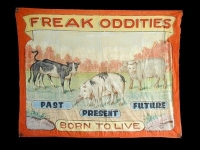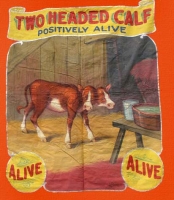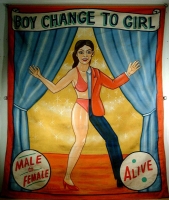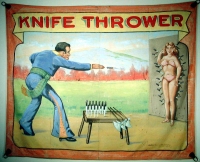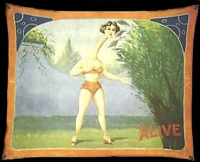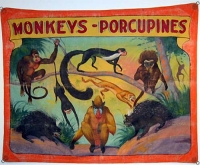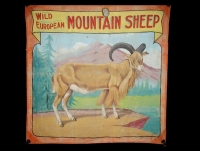The Sideshow Banner Art of Fred G. Johnson
Fred G. Johnson is considered to be the most well known sideshow banner painters in the history of the circus and sideshow world. He had a 65-year career of banner painting, creating many works that are still prized by collectors and museums around the world. He worked for the O. Henry Tent and Awning Company in Chicago for 40 years from 1934 – 1974.
Known as the ‘Picasso’ of circus art, Fred G. Johnson designed advertisements for the Century of Progress Exposition, the 1933 World’s Fair held in Chicago, the city’s old White City and Riverview amusement parks, traveling shows throughout the country, and all the great circuses, including Ringling Brothers, Barnum & Bailey and the Clyde Beatty Circus.
A native of Chicago, Mr. Johnson started running errands at age 14 for the United States Tent & Awning Co. Banner painter H. D. Cummings was looking for someone to clean pots and do odd jobs and took Mr. Johnson on. The older man taught him to paint, something he learned well without any formal training in figure or scene drawing.
Sideshow banner painter Fred Johnson liked to tell stories, and one of his best is about a building he used to work in. Back in 1941, Johnson’s employer, O. Henry Tent and Awning, moved from the corner of Wilson and Clark to bigger headquarters a few blocks away. For Johnson, who painted circus-sideshow banners, this was good news: his canvases were huge, and now he’d have more space to work on them. The only problem was that his new studio had once been a hayloft.
“To get up there,” Johnson says, “I had to climb a straight ladder to get up to the opening and then climb through the opening. It was quite a while before they built stairs.” The place also lacked both plumbing and heat, so Johnson brought in a salamander, a little stove that burned bits of coke. “It got so full of gas, I had to open the doors and let the heat out. To get water, I tied a rope to a bucket and dropped it down through the hole.”
For most of this century, circuses used bright banners to advertise their curiosity sideshows. During his 65-year career, Johnson–who never studied art–painted clowns, snake charmers, sword swallowers, and all kinds of human and animal freaks: “You’d look at some of them, they’d turn your stomach,” he has said.
Randy Johnson, Fred Johnson’s Grandson, has been interested in his grandfather’s work all his life. “It was always around,” he says. “He was my grandfather, and we always went to carnivals and things together.” He first tried to interest galleries in showing his grandfather’s work about ten years ago. Over the years Randy Johnson has collected several books on circus art, and Fred Johnson gave his grandson a scrapbook of photos and clippings.
Though not the most famous in his field–that distinction probably belongs to trained artist Snap Wyatt–Johnson is the oldest living banner painter in the country, and he did it longer than Wyatt or any of his contemporaries. He painted banners for probably every amusement park in Chicago–including Riverview–and he did two banners and some scenery panels for the Century of Progress Exposition in 1933.
Sometimes Johnson painted from models, but more often he used his imagination. There were plenty of times when what he painted didn’t look much like what circus patrons ended up seeing. In “4 Legged Girl,” for example, since he lacked a model, he painted the girl’s extra legs full length, when they were actually shrunken. Then again, accuracy wasn’t very important in the banner business.
“The secret of the banner art is the color and never mind if you exaggerate the subject matter,” Johnson once said about his work. “The idea is to attract attention.”
Johnson used lead-based oil paints. Ground into them were crayons, benzine, and boiled linseed oil, among other things. “Not tubes [of paint] but cans,” Johnson says. “In a good season, I’d use about 500 pounds of white lead.” He’d wet the canvas before painting to keep the paint on one side of the banner. “If it soaked through, you’d go through twice as much paint,” he says. “It would eat it right up off the brush.”
Most circus banners were eight feet high, but Johnson painted whatever size the client commissioned. He also painted smaller portraits, the panels on circus wagons, and in the off-season, merry-go-rounds. The biggest banner he ever painted, he says, was “for a bughouse–we called ’em bughouses, crazy houses–50 feet long and 15 feet high. They wanted clowns. There was about 30 or 35 clown heads on this banner, and it took me about 40 hours.”
His grandson says that by stretching several canvases at once and working on them almost simultaneously, Johnson churned out an average of four banners a day. Unfortunately, most were lost or destroyed as circus banners were slowly replaced by more modern methods of advertisement, and those still in existence are hard to find. Randy owns four of them, and his collection, along with four banners from other family members, makes up about half the exhibit; the Circus World Museum in Baraboo, Wisconsin, which has acquired dozens of Johnson’s banners over the years, lent the rest.
With more and more people learning about and buying folk art, Johnson’s banners have started to become collector’s items. Though Johnson liked what he did, he never thought about it as fine art, and he didn’t date his work. He painted what he was asked to paint. “It was just a job to him,” says Randy.
Johnson claims to have no favorites among his banners, but his grandson says that he did have favorite subjects. Clowns were one of them, and he continued to paint clowns for several years after he retired.
He had his favorite models, too. “Priscilla the Ape Girl would only let him paint her,” Randy says. “And I think he especially liked painting her.”
Fred Johnson was the oldest living sideshow banner artist until his death at 98 years old in 1990.
His works were exhibited in July of 1989 at the State of Illinois Art Center Gallery as Fred G. Johnson’s Sideshow Banners. They also hang in the circus museums in Baraboo, Wisconsin and Sarasota, Florida.
Among his banners auctioned at Sotheby’s in 1981 were Minnie Ha-Ha the Monkey Girl, Josephine the Electric Girl, Albert the Rubber Skin Man, The World`s Strangest Married Couple and Dickie the Penguin Boy.
Though considered nothing more than mere signage by the artists who created them, sideshow banners have come to embody the curious and quirky spirit of early circus and freak show Americana with their colorful and exaggerated promises of sword swallowers, magic, mermaids, bearded ladies, five-legged cows, two-headed calves and much more all alive for your shock and amazement inside for just five cents!













